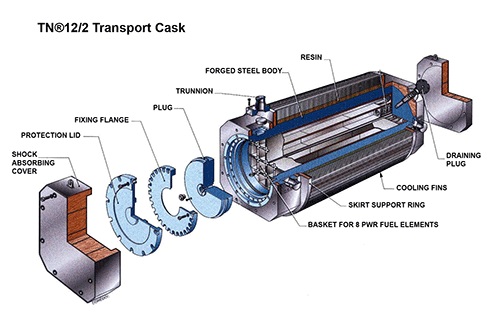(Pease read Part 1 if you haven't.)
Yesterday, I began a blog post about complaints over the plans that Southern California Edison has to select a vendor and purchase spent fuel canisters and dry casks in the near future for storing the fuel being removed from the San Onofre reactors. This is the second part of my post on this topic.
The NRC is working on developing an aging management plan because new regulations require spent fuel temporary storage systems to last at least one hundred years. Previously, they only required that spent fuel temporary storage systems last at least twenty years because they expected there to be a permanent geological repository in the U.S. for spent nuclear fuel. Since the Yucca Mountain Nuclear Repository project was canceled in 2009, it is now estimated that there will not be such a repository in the U.S. before 2050. The NRC is not issuing any license renewals at nuclear plants until this aging issue is resolved. However, they are going to allow the NUHOMS 32PTH2 canisters that SCE is considering to be included under the existing license for the San Onofre plant.
The NRC has not extended licenses past twenty years for what is known as current high burnup nuclear fuel because not enough is known about storing and transporting this type of fuel. It is more than twice as radioactive and much hotter than low burnup fuel that used to be burned in U.S. reactors. The NRC has been allowing the use of this high burnup fuel without requiring research to show that it is safe to store and transport. The protective cladding material that forms the tube that contains the nuclear fuel is vulnerable to heat and can become brittle and crack which increases the risk of radiation release.
There are currently twenty four fuel assembly canisters at the San Onofre plant. They are what are called Failed Fuel Cans. The NRC has required that current spent fuel temporary storage systems be designed so that damaged fuel assemblies can be removed and placed in other storage. The thirty six new fuel assembly canisters of the NUHOMS DSC-PTH2 type that SCE is considering are not designed for easy removal of spent fuel like the existing canisters at San Onofre. There are a lot of damaged fuel assemblies at the San Onofre plant that need to be dealt with.
The NRC has been considering allowing spent fuel from spent fuel temporary storage systems to be returned to a spent fuel pool if the temporary storage fails. That will not be possible at San Onofre because SCE plans to demolish the spent fuel pool there after the nuclear fuel has been moved to a spent fuel temporary storage system. ROSE has pointed out that spent nuclear fuel needs to spend years cooling in the spent fuel pool before it can be moved to a spent fuel temporary storage system. They say that this means that selection of a spent fuel temporary storage system can be delayed while better designs are being considered and that there is no need for SCE to purchase a system now. ROSE wants SCE to delay their selection and purchase of spent fuel canisters and to reopen their bidding process for a spent fuel temporary storage system. Considering the dangers in the use of the old style temporary storage systems, ROSE's suggestion make a lot of sense.
Cast iron type spent nuclear fuel canister:
